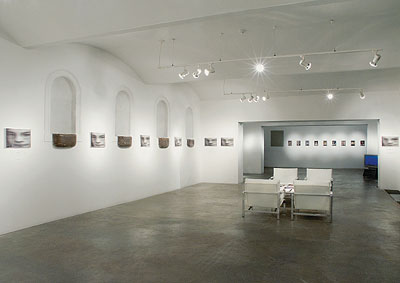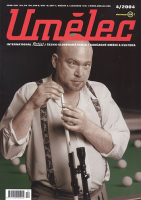| Zeitschrift Umělec 2004/4 >> The Blurred Image | Übersicht aller Ausgaben | ||||||||||||
|
|||||||||||||
The Blurred ImageZeitschrift Umělec 2004/401.04.2004 Tony Ozuna | study | en cs |
|||||||||||||
|
My grandfather was already in his 50s when he first started to take pictures. He only photographed crowds—anonymous faces at high school football games, boxing or masked Mexican wrestling matches at the Olympic Auditorium in downtown L.A. I was his little companion at these events, yet I never even noticed that he was snapping away at faces in the audience, while I was watching Mil Mascaras (the man with a thousand masks) in action. Only years later, I realized that there were shoe boxes filled with these black & white photos—unidentifiable faces that he had accumulated over the years.
My family has no idea why my grandfather took so many of these mysterious photos. He had no aspiration to be an artist. He was a barber, the owner of two barbershops, and a veteran of WWII. He was also a recluse (at home), a hypochondriac and a womanizer, so maybe that’s where I can begin to understand his strange interest in taking so many puzzling photos---many were out of focus, and most were badly framed. Sometimes he shot enigmatic variances or close-ups like legs, shoes marching up or down the stands, or blurry people walking back to their cars, in the parking lot, after the event. My grandmother threw all of these photographs away after he died. Last year’s exhibit of Yoko Ono’s at Prague’s Kampa Museum, “Women’s Room” included 21 identical blurred faces, but with different short texts beneath the image. This section of her four part show, titled “Vertical Memory,” is a series of blackish-white photo montages created by combining photographs of her father, her last husband, and her son. She used photographs of their faces facing the same direction, overlapped them and morphed them into one. According to Yoko, every photo represents the man who was overlooking her at a particular moment, when she experienced something of significance in her life. So, the text under “Father” reads “I was two and a half when I arrived in San Francisco on a liner to meet him for the first time. He came on board, kissed my mother, and then looked at me looking up at him.” The text under “Priest” reads “He was called into perform the last rites and suggested I give my last confession. I refused,” and “Doctor VII” reads “He performed a few abortions.” Whether these are really computer manipulated photos is questionable, because the blurred portraits resemble Yoko more than anything else. Through a foggy lens, Yoko Ono’s face is such a blur to me that she looks like her dad, husband and son in one. In the background, from another section of the show titled “Blue Room,” Yoko played ambient music that builds to a heavy rocker, for an overall serene effect of music in pictures. “Music in Pictures” is actually the title of a recent photo exhibit by Mario Bihari and Bjorn Steinz, which was just around the corner from Yoko’s show, at Gallery Ecceterra. Bihari is best known as an up and coming Roma musician, who plays with Zuzana Navarová’s group Koa. His photographs are set apart from the norm, because he is totally blind. So his shots are done in collaboration with Steinz. Yoko’s computer-composed blur pales in comparison to Mario Bihari’s unfocused, color images. Because more than just exhibiting fuzzy shapes, Bihari is able to capture an atmosphere that other photographers couldn’t ever stage. He befriends fellow Roma in villages in Slovakia, for instance, with accordion or clarinet in hand. In someone’s home, a song begins and then another until the atmosphere is just right, but still never in Bihari’s control. Men are playing violins, singing, men and women are dancing—everyone is drinking, including Bihari—not for show, and then one can imagine Bihari pulling out (maybe even fumbling) his camera then he snaps away. The reaction of those photographed in these images to Bihari’s innocent audacity is the blurred beauty in these shots. Bihari provides commentary underneath his untitled photographs. For instance, beneath the photo described above, Bihari writes “In a little space (a home), about 15 people were dancing, then suddenly I realized someone was singing at the doorway. I tried to get a real close shot of him, because I wanted to capture that feeling of music, he had inside.” “Spirit photography” was first used as a term in the 1920s to describe art photographers using double or multiple exposures to try and conjure up the incorporeal world around us. It is a term used now to describe photography, which captures “spirits” or ghosts on film, mostly new-age stuff. I would use this term (in both usages) to describe photos by Mario Bihari, because sometimes his photos look like multi-exposures and they conjure up ghost-like images, without being kitsch-new age. Furthermore, through his images, we see how he (as a blind person) sees at best, though without the benefit of hearing the incessant soundtrack that accompanies his life among fellow musicians. Spirit photography by Czech artists Josef Vachal, Frantisek Drtikol and others was included in the Rudofinum’s monumental exhibition, “Czech Photography 1840—1950, A Story of a Modern Medium.” There seem to be thousands of photographs in this show, but a large blurred image by Karel Hajek is possibly the most powerful one. Titled, “Demonstration at the Charles University, (1934)” it is a shot from a balcony or roof, looking down on a swirl of heads and bodies—it looks like a 1930s mosh pit. Since most of the young men are sporting hats and ties, the scene looks both fun and dangerous at the same time—it is a blurred image of slam dancing in a silent, black and white film. Hajek’s photograph was published in 1964, under the title “Demonstration Against Fascism at Charles University, 1936. However, in actuality, it is a photo of a demonstration organized at the end of 1934 by German Nationalist students at the university to protest against the Czechs presentation of university insignia. So, the swirl of bodies was not an anti-fascist event, at all, yet the image was used to stir up Czech nationalist sympathy under communism and a different type of sympathy in the West. This manipulation of reality by photographs is found not only in a nation’s history, but even in the personal. In his book of essays on photography, Ghost Image, French novelist and photography critic, Herve Guibert, writes that each individual, personal history is doubled or multiplied by its photographic history, imaged, imagined. Bihari and Steniz’s photos inadvertently are all a blur. Non-blind artists from Drtikol to Yoko Ono manage this same effect with craft. My grandfather achieved the fuzzy image without any skill at all. Life is just a blur and Guibert’s text on photography is a despairing celebration of the image. Guibert writes that photography is also an act of love, because at its best, it captures—suspends in time--forbidden moments, emotions and temporal states which can never be retrieved again in real life. He describes the most important photographs he has encountered in his life as ghost images: “images that have not yet issued, or rather, of latent images, images that are so intimate that they become invisible.”
01.04.2004
Empfohlene Artikel
|
|||||||||||||









Kommentar
Der Artikel ist bisher nicht kommentiert wordenNeuen Kommentar einfügen